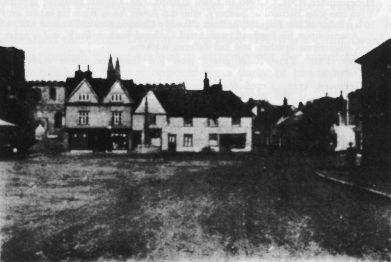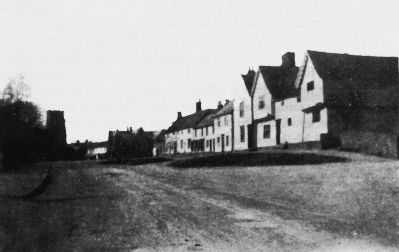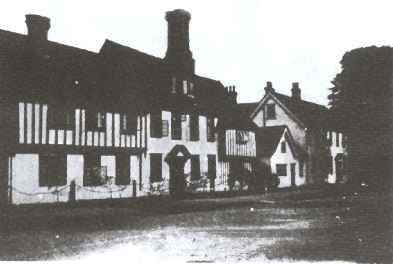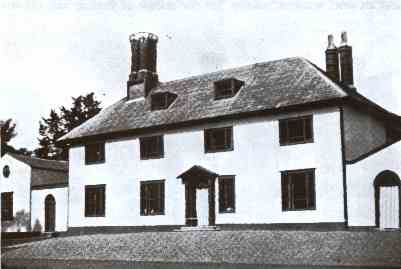The Town in the Sixteenth and Seventeenth CenturiesThe Honor of Clare had become a Crown possession at the end of the fifteenth century and after 1558 it was included in the administration of the Duchy of Lancaster, as it is today. In Clare itself town government was in the hands of the headboroughs (known in medieval times as chief pledges), who met regularly at first four times a year and later in a twice-yearly court which was in effect the continuation of the medieval court leet. Moreover, the men who were elected headboroughs seem also to have been the most influential members of the church vestry, which at that time had a vast amount of civil as well as ecclesiastical work. We have seen that Clare never developed fully as a borough; but the headboroughs represented a small close corporation and were active in working for the benefit of the tow. This can best be seen in the way they obtained the demesne lands of the manor as a town pasture, a part of which is still called "the common". In the later Middle Ages there had been several changes in the manorial economy. Manors in the neighbourhood had suffered severely from the Black Death and other pestilences. For this and other reasons labour had become more scarce, wages rose, and the lords tried a number of expedients meant to be only temporary, but some of which proved permanent. At Clare parts of the manor were leased out, at first for short periods. Similarly the mills were farmed out. Then in 1495 the site of the whole manor was leased to Robert Turnebull. Meanwhile there was a movement to obtain the manorial pastures for the town; and in 1534 a grant of these lands was obtained from Queen Katherine by George Whatlock, William Gilbert and two others on behalf of the town. In 1554 Ambrose Gilbert, William Fryer and John Fenne representing the town paid on e hundred marks for a confirmation of this grant. The pasture was to be used for the benefit of those owning less that fifteen acres of land; according to the church records the common was divided into cattle walks, each tenant paying twenty pence for a summer, and eight pence for a winter walk. After the yearly rend of £3 6s. 8d. had been paid to the crown the poor in Clare were to be given any profits arising from the administration of the pasture. Early in the seventeenth century there were several lawsuits over the supposed maladministration of these lands, and in 1610 there was a settlement regulating the position and it was again stated that any profits should go to the poor. Our knowledge of Clare in the early modern period is largely derived from the court rolls known as the Verdicts of the Headboroughs. In the courts, officials were elected as in medieval times, every year two constables, two aletasters or clerks of the market, every two years two bailiffs who were the senior headboroughs. Every attempt was made to keep the town orderly. Innkeepers were reprimanded for not keeping the peace; any suspicious characters were fined as "Evesdrepers and night walkers". Inhabitants were frequently fined for allowing pigs to wander in the streets for obstructing or digging up the highway, or for throwing filth into the road. One man "doth anoy the church and markit path with his suds". Butchers were regular offenders in throwing their "paunches and offall" into the streets. Fires were a real danger and the headboroughs ordered that chimneys were to made of brick and built four a half feet above the roof, but this was frequently evaded; inhabitants were fined for having fires in rooms without a chimney. 
The Market Hill
There were careful regulations to safeguard the trading interests of the town. No out-of-town butchers were to hawk their meat in the town except on market days, on pain of a ten shilling fine. Sunday trade was forbidden; and every Clare trader was subject to a close supervision. Butchers were forbidden to slaughter openly in the streets or market place, or to sell unwholesome meat; bakers and brewers were to observe the law. No market shop was to be closed; and there was careful supervision over sales in the market. Among the Verdicts of the Headboroughs are some of the market cries heard in Clare market; the crier himself seems to have written some of these, and they make interesting reading. To quote a few :- 18 December 1617. Memorandum…that one John Cope of Tuddington in the County of Bedford, husbandman, did bargaine and openly sell for v li. Ijs. and viijd. Unto one Thomas fflacke of Stansfeilde in the countye of Suff. in the open markett of Clare --- One trotting cot of the age of two yeares and a half, of an Irone Gray collor, and yt was verified by the testimonye of on John Woman of Tuddington aforesaid, husbandman, that the said John Cope was true owner of the said colt, in the presence of Wm. Constable, Peter Farmer (Bailiffs). 9 October 1962. Cryed etc. one broune blacke horse Aboute 14 hands high, with a starr on his foorehed and whight slips on one of his nostrills, with one whight foot behinde, and a walle eye on the oft side, and the other eye is in his heade, but he is allmost blinde of both, and two sadle spots on etch side of this back, taken or strayed oute of the pastur of Mr John Brooke, minister of greate yeldom in Essex etc. 28 March 1701 Cryed in Clare markett one John Wade the sonn of William Wade of Clare, glover, that non of the Kings subjects should lend the said John Wade any thinge upon his fathers account, nor pay him any of his fathers debts. 11 September 1701. Cryed in Clare markett, one Thomas sparrow, apprentice to one John Barnard of Sudbury, who did Runn Away from his master on the 23rd day of last August; he hath a Ruddy Complection and broune hair, with A scarr upon his forehead, with a sad Cullered fuschon frock, and payer of Callimankoo britches, and sad cullered stockens. 2 July 1707. Cryed … A gilded bible lost from the schole chamber last Tuesday. 2 February 1710. Cryed downe in Clare markett, one Sarah Wordely, the wife of ould Mr Wordely of Glensford in Suff. For westeing and makeing away her housbands Estate, and this I was ordered to doe by Rodger Wordely his sonn, who did promise me I should sustain no wrong for doing. In addition to the petty criminal work of the headboroughs' courts, much of the town business was transacted in the church vestry, meeting once or more in the year, sometimes in the market house, sometimes at one of the inns, and elsewhere. The vestry controlled the administration of the common lands, electing two wardens to be in charge, also a bailiff or pinder of the pasture whose duty it was to impound stray cattle, keep up the fences and spread out dung and molehills. In the vestry the accounts of the churchwardens, overseers, surveyors and constables were supervised. The local administration of the poor law was in the hands of churchwardens and overseers, under the supervision of the justices of the peace. Pauper children were apprenticed out to masters in the neighbourhood. We do not know the date of the building of a House of Correction at Clare, but 1660 it was said to be badly in need of repair, and it was ordered in Quarter Sessions that a new House should be built. In the House the inmates were mainly occupied in the spinning of yarn and waving into cloth. In the Quarter Sessions money was allotted for the upkeep of roads and repair of bridges, and the local vestry supervised the expenditure of the money and work involved. The vestry further had a vast amount of business which was concerned with both national and local politics. It arranged, for example, for the payment of ship money in 1637; and at the end of the eighteenth century it had charge of local schemes for resisting French invasion. As for local matters, it saw to the upkeep of a fire engine; it paid a small sum for every fox that was caught; it dealt with gleaning after harvest; the town crier had to proclaim the orders of the vestry, which included miscellaneous rules such as prohibiting fireworks in the street and forbidding bathing in the river. Many of the leading inhabitants of Clare were clothiers, to whom reference is made below. An outstanding personality was Roger Barrow, who lived at the end of the sixteenth century. He seems to have been a newcomer to the place and is described variously as grocer and yeoman; possibly he was also an innkeeper, for he bequeathed the Green Dragon to his wife. He was a churchwarden and was probably over-zealous in carrying out the manifold duties of that office, for he was opposed by a party of townsmen. As a result, in 1597 he instituted a suit in chancery against thirteen of the chief inhabitants, alleging that he had personally spent large sums of money on the town and had been unable to recover his costs. On the other hand his opponents declared that many of his actions had been highhanded and unnecessary. The old market house, they said, only needed repair, whereas Barrow had pulled it down, but had not completed a new one. He had obtained large quantities of timber for the repair of the town bridges; but they declared that he had sold part of the timber and only repaired the Baybridge on the Cavendish road. The result of the case is not known, but it seems likely that Barrow had overreached himself; we cannot substantiate his claim that he had spent £240 on the town, for the churchwardens' account-book begins only in 1602; but he was certainly exaggerating when he said that he had expended large sums on the repair of the church, for in 1602 the chancel was said to have needed repair for the past twelve years and the whole church was in poor state. The town itself had altered little from medieval times. The names of some of the streets had changed. The road north of the church was now called Callis Street (a name most probably derived from Calais and it association with the woollen industry). Houses were being built towards Chilton, along the road still called Gosford Street. A bridewell is first mentioned in 1700 but the name Bridewell Street alias "Gosworth" only occurs in the later nineteenth century. The name of Common Street is found in a will of 1727, and we know that encroachments were being made on the common lands. East of the church the name of Rotten Row was replaced by Church Street. More houses were being built in Cavendish Lane; and there was a turnpike at the Baybridge, earlier called Pysenebregge, over the Chilton stream. In the market the small houses separating Market Street and Rotten Row were often in the possession of out-of-town traders. The market cross begun by Roger Barrow was probably a small timbered building standing on strong uprights; he claimed that it was a convenient shelter for trades in bad weather. 
Gosford, later Callis, Street
(Showing the Maltings before the North wing was demolished)
With the existence of old leases it is easier to trace the descent of houses. We have mentioned the medieval inns. In the sixteenth century the present Bell Hotel was called the Green Dragon, and was in the possession of Roger Barrow. The "chief house" of Gabriel Goulding was the Boar and Griffin extending down the east side of Mill Lane, later Malting Lane, and it paid the biggest rent according to the borough rentals. Some of the beautiful dwellings which distinguish Clare today probably belonged to the leading clothiers. Nethergate House, now used as a hotel, is an outstanding example of half timber work. It was built in the early sixteenth century, though nothing is known of its first owners. Some of the fine timber work is of fifteenth century date - the great oakboard spanning the open fireplace in the hall has two carved rows of battlements similar to those in Clare church; and it is possible that the builders of this house, as of others in Clare, used timber that came from the friary at the time of its dissolution. 
Nethergate House
For the greater part of the seventeenth century Nethergate House was owned by the Crosse family. Francis Cross, clothier, who succeeded his father Francis in 1644, probably made important alterations in the dwelling, such as a small staircase and gable at the rear and an oriel window nearby, for the initials of Francis and his wife Elizabeth with the date (F.C.E.1644), are carved on the outside tiebeam. There is a fine Caroline staircase made of oak with turned banisters and elaborate carving. From the hall there is another staircase, of the date of William III, at which time the frontage of the house was altered, the roof of the middle portion raised, the wall plastered over, and two dormer windows built; but the two timbered ends retained their original features, with sixteenth century pattern carved on the horizontal beams. The plan of the house can be compared with that of Paycocke's house in Coggeshall, save that in Nethergate House the east wing which served for weaving sheds has been demolished. 
The Cliftons
One of the most notable houses from an architectural point of view is the Cliftons, at the west end of Nethergate Street. It is a late eighteenth century adaptation of an earlier building whose origin is not known. Its front elevation, not quite symmetrical, is beautifully proportioned. Its most decorative feature is a fine cut and moulded brick chimney stack of early sixteenth century date; and one of the rooms had Jacobean panelling. In the eighteenth century the house was in the possession of a branch of the Ruggles-Brise family.
|



